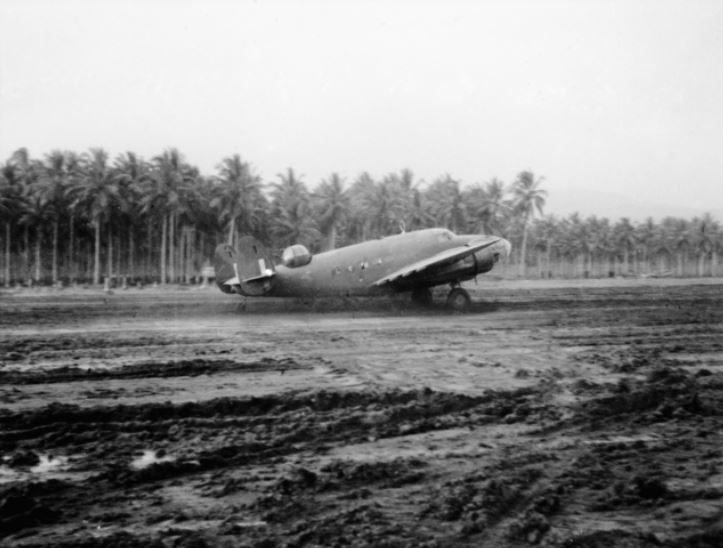No. 6 Squadron RAAF
From Our Contribution
 Hudson from 6 Squadron on Gurney Field (Milne Bay) Sep/Oct 1942 - AWM photo | |
Brief History
The original 6 Squadron Australian Flying Corps was raised at Yatesbury, England on I Sep 1917 as a Fighter/Scout training unit. 6 Squadron was equipped with Hawker Deamon and later Avro Anson aircraft, was formed at Richmond, New South Wales as No. 4 (Genera Reconnaissance) Squadron, on 3 May 1937. It was renumbered as No. 6 Squadron in January 1939. The Squadron undertook reconnaissance and bombing exercises from Port Jackson, Cabo Island and Cape Byron, in co-operation with the Royal Australian Navy.
In August 1940, the Squadron searched in vain for a German raider which had sunk the SS Tourikina on the 20th. From February to November 1941, the Squadron flew seaward protection patrols over the approaches to Sydney Harbour. In May 1941, Lockheed Hudson aircralt were issued, and the Squadron flew patrols in search of enemy raiders and submaribes. in late 1941, early 1942 modified aircraft undertook very long range recce flights. On 5 June 1942, a Hudson attacked a suspected submarine near Newcastle. On 23 Aug 1942 the Squadron deployed to Horn Island, North
Queensland, with a detached flight being sent to Milne Bay.
Following the Japanese attempt to invade at Milne Bay, 'six Hudsons effectively bombed and strafed enemy positions and stores dumps. During 29 Aug 1942 Flight Lieutenant D.W. Colquohoun, made a solo attack on an enemy force of one cruiser and eight destroyers, scoring a direct h1t on the stern of a destroyer. Victory at Milne Bay was won early in September 1942 and the Hudsons of No. 6 Squadron ranged all over the Trobriand, 'Entrecastcaux, Rossel and Louisiade Islands in search of barges, landing strips and possible float plane bases. Between 5 and 25 Sep 1942, No. 6 Squadron averaged eight missaons a day operating from the Seven Mile Airstrip at Port Moresby, the Hudson crews took off before dawn and returned in darkness, in appalling weather. On 11 Oct 1942, the Squadron moved to Wards Strip, near Port Moresby. In conjunction with 100 Squadron, 6 Squadron was responsible for the entire seaward reconnaissance in the New Guinea area, ndertaking unspectacular and unrewarding anti-submarine patrols and other flights over enemy controlled territory.
Between 6 and 28 Nov 1942 the Squadron commenced supply dropping missions to Buna, Ioma, Kokoda and the Baibara Islands. ln addition, sick troops were flown out of Wanigela Mission. The Squadron deployed to Turnbull Field, Milne Bay. late in December to undertake normal seaward, photographtc and anti-submarine patrols. On 17 Jan 1943, a successful attackby enemy bombers on Turnbull Field caused damage to the 6 Squadron dispersal bays and aircraft limiting their ability to operate for some weeks. From March to September 1943, the Squadron operated over the Bismark Sea searching for Japanese landing barges, flying recon missions and carried out convoy escorts.
During the night of 20 October, 6 and 1OO Squadrons combined in an attack on enemy warships near Cape St George, and on 14 November a direct hit on a 8,000 ton ship in Simpson Harbour, for which the pilot was awarded the Distinguished Flying Cross. During November 1943, 6 Squadron joined 71 Wing at Vivigani, Goodenough Island to strike targets in New Britain, conccentrating on the Rabaul airfields, harbour installations and shipp1ng. Thede operations contmued until the end of March 1944 before returning to seaward searches, anti-submarine patrols and photographic missions. After a nine-month break, Rabaul was agam the target for 6 Squadron aircraft during January 1944.
On 20 Nov 1944, the Squadron supported the 5th Division in the Sepik River area of north-east New Guinea by attacking enemy stores and bivouac areas, staging through Madang, FinschhaJen and Saidor. This was followed by further attacks agamst targets in New Britain and supply dropping missions to Army patrols operating on that island. The Squadron moved to Horanda, Dobodura, on 26 Jan 1945, and carried out attacks against targets at Ralum, Sulphur Creek, Tobera, Vunakanau and Matupi Island in New Britain. Supply drop missions were also flown in support of Army patrols at Ganna and Lakirri.
During February 1945, the Squadron attacked targets on New Britain and on Sepik River on the New Guinea mainland. Until the end of the war, 6 Squadron flew close support missions from Jacquinpt Bay, and from the end of April, until 13 May, a detachment of eight Bcauforts operated from Tadji, attacking targets on the Wewak Peninsula. These were the final wartime operations of 6 Squadron. No. 6 Squadron returned to Australia on 18 Oct 1945, and was disbanded at Kingaroy, Queensland. on 31 October.
Ground crew
- William Kenneth Watson 12 Mar - 12 Jul 1945
Notes
Content has come from Units of the Royal Australian Air Force - A Concise History - Volume 3 Bomber Units pqges 14 to 17 - Australian Government Publishing Service - 1995